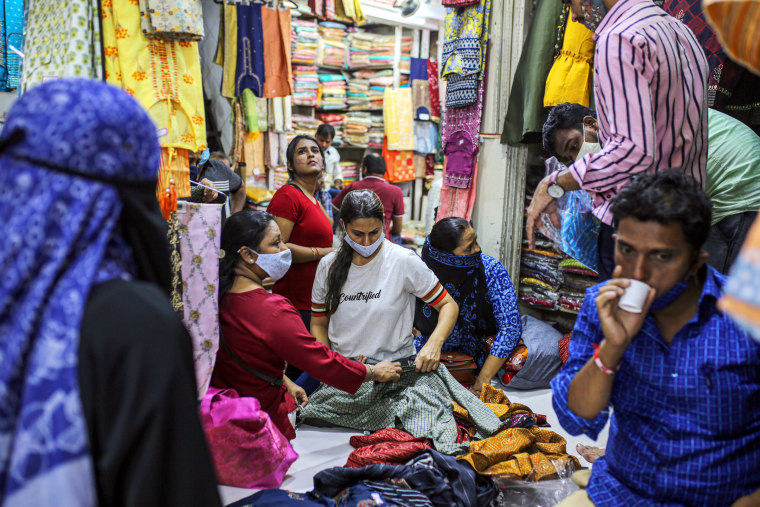As the coronavirus pandemic tears across India, forcing garment factories to shut down or work at half capacity to stem new cases, retail suppliers are scrambling to move production to China. But with trade war tariffs still in play, the shift could mean higher prices for U.S. consumers.
Infections have swelled in India since February, with more contagious variants spreading as massive crowds gather for religious festivals and political rallies. With around 22 million confirmed infections, health experts have warned the worst is still ahead.
While clothing suppliers say they can absorb the costs in the short term, analysts say retailers will eventually have to raise prices, unless suppliers can find cheaper labor and production options.
“Once India opens back up, things will pivot back because the consumer can’t be hit,” Brett Rose, CEO of United National Consumer Suppliers, an international retail wholesale and distribution company, told NBC News. “Now, more than ever, we want to buy new shirts, new pants and new bags. A closed factory doesn’t help that.”
As virus case counts in the U.S. continue to decline, spending is roaring back in anticipation of in-person socializing, office life and the return to in-person schooling. Consumer spending, which accounts for two-thirds of economic growth, increased by 10.7 percent in the first quarter, according to the Commerce Department. Stimulus checks have padded some wallets, and personal household income is at a record high. Gross domestic product growth hit 6.4 percent last quarter.
“It’s just a perfect storm right now,” said Rose, whose partner factories in India are not expected to return to production until June 7. “We just have to run out of fabric.”
India makes up about 16 percent of textile imports to the U.S. and about 5 percent of apparel and accessories, according to an analysis of U.S. International Trade Commission data by the Peterson Institute for International Economics. While the country constitutes a smaller fraction of imports as compared to China, it still plays a significant role in certain sectors, including raw gems, which makes it difficult to move supply chains outside the country, said Mary Lovely, a senior fellow at the Peterson Institute and an economics professor at Syracuse University.
“If India dropped off the face of the world, where you would notice an impact is certainly in manufactured goods, textile and mill products and things like cloth and towels,” she said. “You don't just move supply chains. They’re not like pins on a map.”
Gap Inc. CEO Sonia Syngal told investors last week that the company is facing supply chain and raw material challenges from countries where it sources goods, including India.
“We're looking closely at all of that and working hard to do what we've been doing, which is use our pricing power to offset all of those issues,” she said.
Williams-Sonoma, Inc., which owns West Elm and Pottery Barn, also reports it has “elevated’ backorders from production issues in India, Williams-Sonoma CEO Laura Alber said during an earnings call last week.
The global pandemic has put added stress on fast fashion’s already strained workers. Gokaldas Exports Limited, an apparel manufacturer that supplies retailers such as H&M, Gap, Walmart and Abercrombie & Fitch, closed one of its factories last year and laid off more than 1,200 workers as customers canceled orders and dealt with excess inventory from spring 2020.
As another wave of the virus forced factories to close, Gokaldas CEO Sivaramakrishnan Vilayur Ganapathi told investors in May that the company is “exploring options” to work overtime or on weekends to meet their order deadlines after state-mandated lockdowns lift.
“The apparel industry has been traditionally a labor-intensive and low-wage industry,” Ganapathi said. “This calls for a highly efficient manufacturing capability and the supply chain management ability to manage the large number of SKUs that we produce.”
Orders in India that usually ship within 30 days are now taking 70 days, Rose said. Not only are Indian factories stalled, but cargo ships are overstocked as businesses rush orders across seas to fill store shelves, hiking up shipping prices.
However, this latest hike in pressure on manufacturers should lift in a few months, Rose said.
“There is going to be an inflection point where companies can only bear so much burden,” he said. “Something has got to give for the consumer.”
